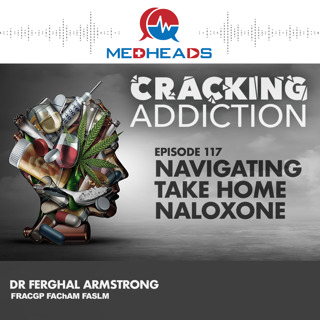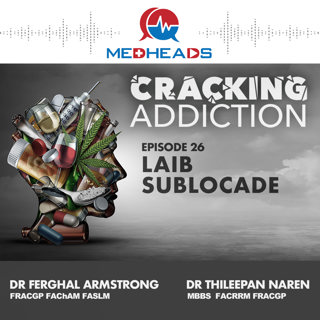
LAIB - Sublocade
Cracking Addiction discusses Sublocade one of the LAIB preparations available and how to commence, maintain and manage any dose changes or complications associated with Sublocade.Sublocade is a long acting injectable buprenorphine (LAIB) manufactured by Invidior that uses the “Atrigel” system to provide for a sustained and prolonged delivery of buprenorphine into the systemic circulation after subcutaneous injection.Discussions and comments in our videos are for informational purposes only and should not replace the advice of your medical professional. Please consult with your doctor before making any changes to your medical treatment or lifestyle.Latest Blogshttps://www.meducate.com.au/blogAbout Meducate ®Meducate provides online education for doctors, clinicians, health professionals and the public.See the website to browse the many different talks and courses available https://www.meducate.com.au
9 Feb 202215min
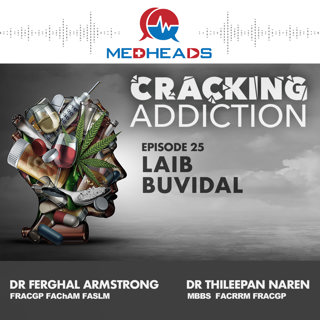
LAIB - Buvidal
Cracking Addiction discusses Buvidal one of the LAIB preparations available and how to commence, maintain and manage any dose changes or complications associated with Buvidal.Buvidal is a long acting injectable buprenorphine (LAIB) preparation manufactured by Camurus and uses “FluidCrystal” technology to provide for a sustained and prolonged delivery of buprenorphine into the systemic circulation after subcutaneous injection.
3 Feb 202217min
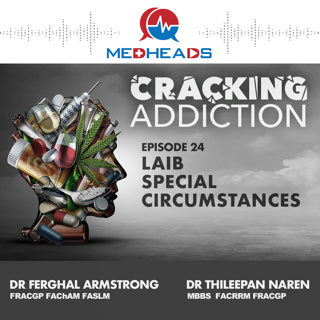
LAIB Special Circumstances
Cracking Addiction discusses some of the special or difficult circumstances of prescribing LAIBs including intoxicated patients, pregnant patients, patients with chronic disease, patients with acute pain and our management strategies in these situations.
26 Jan 202219min

LAIB first dose considerations
Episode 23 of Cracking Addiction explores commencement of patients on LAIB, side effects and risks of LAIB, discussion about precipitated withdrawal and when and how to review patients
20 Jan 202220min

Long Acting Injectable Buprenorphine (LAIB) - Introduction
An Introduction to Long Acting Injectable Buprenorphine (LAIB)Long acting injectable buprenorphine (LAIB) are long acting buprenorphine depot preparations that are injected subcutaneously and provide patients with a sustained release of buprenorphine for the duration of the depot preparation. Currently, two LAIB products are available for the Australian market. They differ in their formulations, administration and pharmacology.See blog for further informationhttps://www.meducate.com.au/blogAbout Meducate ®Meducate provides online education for doctors, clinicians, health professionals and the public.See the website to browse the many different talks and courses availablehttps://www.meducate.com.au
12 Jan 202218min
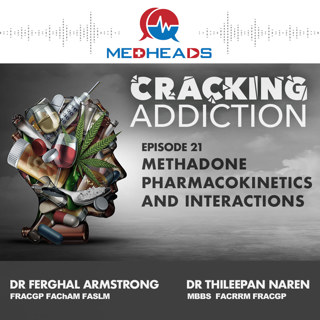
Methadone pharmacokinetics and interactions
Episode 21 of Cracking Addiction explores methadone pharmacokinetics, breakdown and interactions within the body and interactions with other drugs.Methadone is a drug with a wide variability in its absorption with oral bio-availability ranges from 35% to 100%. This is a significant amount of variability and explains why the same dose of Methadone can impact different patients differently. Methadone is metabolised within the liver by the cytochrome P450 enzymes but mainly 3A4. There is a 17-fold inter-individual variation of methadone blood concentration for a given dosage and variations in metabolism account for a large part of this variation. Kinetic interactions influenced by the CYP 450 enzyme can affect plasma methadone levels.• Inducers of CYP450 can• Accelerate the metabolism of methadone• lower methadone plasma levels• Precipitate opioid withdrawal • Inhibitors of CYP450 can • Slow the metabolism of methadone• Increase plasma levels• Produce opioid toxicity (sedation, overdose)Methadone is excreted renally with approximately 10% of drug renally eliminated unchanged. Renal excretion of methadone urinary pH dependent with increased Methadone excretion noted at pH less than 6 and decreased Methadone excretion at higher pH levels.About Meducate ®Meducate provides online education for doctors, clinicians, health professionals and the public.See the website to browse the many different talks and courses availablehttps://www.meducate.com.au
22 Dec 202116min
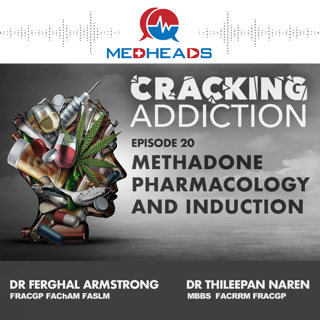
Methadone pharmacology and induction
Episode 20 of Cracking Addiction explores methadone, its origins, the pharmacology behind methadone and how to commence a patient on Methadone.Methadone is a synthetic long acting mu receptor agonist suitable for the treatment of opioid use disorder. Methadone has a longer plasma half life than morphine (average 22 hours (15-32 hours) vs 2 hours for morphine) which permits once daily supervised dosing.https://www.meducate.com.au/blogAbout Meducate ®Meducate provides online education for doctors, clinicians, health professionals and the public.See the website to browse the many different talks and courses availablehttps://www.meducate.com.au
15 Dec 202122min
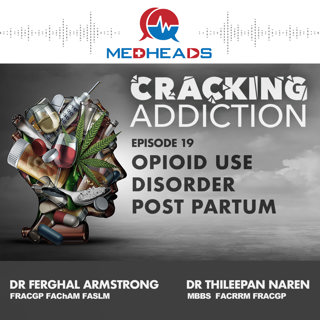
Opioid use disorder Post Partum
Episode 19 of Cracking Addiction explores the management of opioid use disorder in the post partum period.Post birth the patient's usual oral methadone dose can be continued in the peripartum and post partum period. There is a theoretical concern in the postpartum period of over-sedation as methadone levels may increase as plasma volume and hepatic clearance normalise post the delivery of the child. Latest Blogshttps://www.meducate.com.au/blogAbout Meducate ®Meducate provides online education for doctors, clinicians, health professionals and the public.See the website to browse the many different talks and courses availablehttps://www.meducate.com.au
9 Dec 202111min
